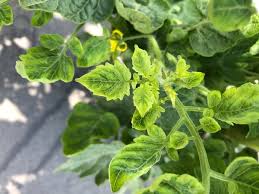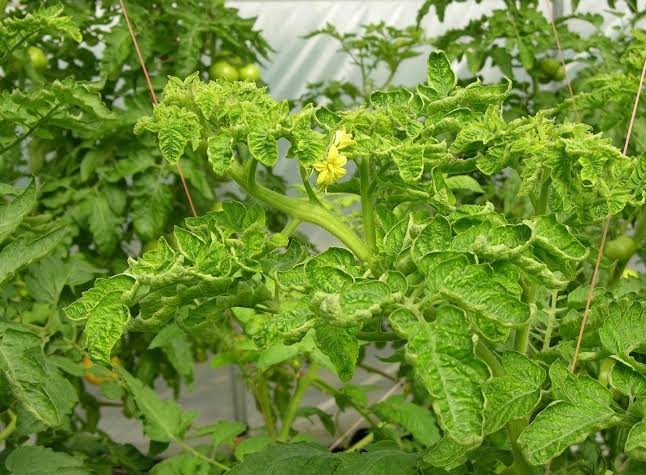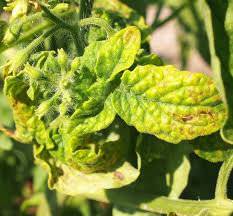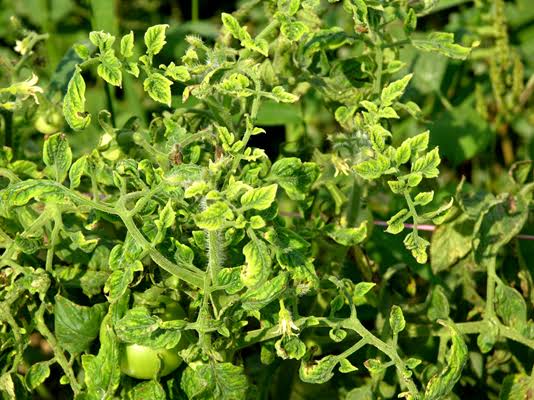Tomato Yellow Leaf Curl Virus (TYLCV), scientifically known as Begomovirus, is a harmful plant virus that affects tomato plants. This virus is a significant threat to tomato crops worldwide, causing substantial losses in agricultural productivity.
TYLCV primarily spreads through whiteflies, tiny insects that feed on the sap of infected plants and transmit the virus as they move from plant to plant. Once a tomato plant is infected, TYLCV induces characteristic symptoms such as yellowing and upward curling of leaves, stunted growth, and a decrease in fruit quality and yield.
Farmers face considerable challenges in managing TYLCV due to its ability to rapidly spread and the lack of effective control measures. Crop rotation and the use of insecticides are common strategies, but they often provide only partial success. Additionally, the virus can persist in weed hosts, complicating efforts to break the disease cycle.
One of the notable features of TYLCV is its impact on the global tomato industry. Tomato is a vital crop in many regions, serving as a key ingredient in various cuisines. The economic consequences of TYLCV can be severe, affecting livelihoods and food security.
Scientists and agricultural experts continually strive to develop resistant tomato varieties to combat TYLCV. Through breeding programs, they aim to create tomatoes with genetic traits that make them less susceptible to the virus. However, the development and implementation of resistant varieties can be a time-consuming process.
In some cases, farmers resort to cultural practices such as using physical barriers or applying reflective mulches to deter whiteflies and reduce the likelihood of TYLCV transmission. Nevertheless, these methods may not provide complete protection, emphasizing the need for a holistic and integrated approach to managing the virus.
Collaboration between researchers, farmers, and policymakers is crucial to developing effective strategies for TYLCV control. Public awareness campaigns can also play a role in educating farmers about the importance of early detection and implementing preventative measures to minimize the impact of this devastating virus.
However, Tomato Yellow Leaf Curl Virus poses a significant threat to tomato crops globally, impacting both farmers and consumers. Efforts to manage and control TYLCV require a multidimensional approach, combining scientific research, technological innovation, and agricultural best practices to ensure the resilience of tomato crops in the face of this persistent challenge.
Read Also: Alaska Pollock Fish Farming and Care Guide
Plants Affected by Tomato Yellow Leaf Curl Virus (Begomovirus)

Tomato Yellow Leaf Curl Virus (TYLCV) affects a wide range of plants, with tomatoes being the most notable host. Besides tomatoes, TYLCV can also infect various other plant species, particularly those belonging to the Solanaceae family. This family includes several economically important crops. Some of the plants affected by TYLCV include:
1. Peppers (Capsicum spp.): Peppers, including bell peppers and chili peppers, are susceptible to TYLCV. Infection can lead to similar symptoms as observed in tomatoes, including leaf curling and yellowing.
2. Eggplants (Solanum melongena): Eggplants, also known as aubergines, are part of the Solanaceae family and can be affected by TYLCV. Symptoms on eggplants may include leaf curling, yellowing, and stunted growth.
3. Potatoes (Solanum tuberosum): While potatoes are not as commonly affected as tomatoes, they are still susceptible to TYLCV infection. Infected potato plants may exhibit symptoms such as leaf curling and yellowing.
4. Tobacco (Nicotiana tabacum): Tobacco plants, belonging to the Solanaceae family, can also be affected by TYLCV. The virus can impact the growth and quality of tobacco plants, affecting both crop yield and economic value.
5. Petunias (Petunia spp.): Ornamental plants like petunias, which are part of the Solanaceae family, can serve as hosts for TYLCV. This highlights the potential for the virus to affect not only economically important crops but also ornamental plants.
It’s important to note that TYLCV primarily targets plants in the Solanaceae family, but the specific impact can vary among different plant species. Monitoring and implementing preventive measures are crucial for minimizing the spread of TYLCV across various crops and ornamental plants, thereby protecting agricultural productivity and landscape aesthetics.
Damages Caused by Tomato Yellow Leaf Curl Virus

Tomato Yellow Leaf Curl Virus (TYLCV) inflicts significant damages on affected plants, particularly on tomatoes and other crops in the Solanaceae family. The damages caused by TYLCV include:
1. Reduced Yield: One of the most pronounced effects of TYLCV is a substantial reduction in crop yield. Infected plants often produce fewer fruits, and those that are produced may be smaller in size and of lower quality.
2. Stunted Growth: TYLCV stunts the growth of infected plants, leading to overall smaller and less vigorous plants. This can further contribute to diminished crop yield and economic losses for farmers.
3. Leaf Curling and Yellowing: TYLCV induces characteristic symptoms, including the upward curling of leaves and yellowing of leaf margins. This not only affects the visual appearance of the plants but also hampers their ability to photosynthesize and produce energy.
4. Deformed Fruits: Infected tomato plants may yield deformed fruits with irregular shapes and sizes. These fruits are often unmarketable, leading to financial losses for farmers who depend on the sale of high-quality produce.
5. Transmission to Other Plants: TYLCV spreads through whiteflies, and infected plants can serve as sources of the virus for nearby crops. This transmission to other plants exacerbates the economic impact of TYLCV by affecting a broader range of agricultural products.
6. Economic Consequences: The cumulative effect of reduced yield, lower fruit quality, and increased production costs due to the need for control measures can have severe economic consequences for farmers and the agricultural industry as a whole. Losses in income and livelihoods may occur, especially in regions heavily dependent on tomato and related crops.
7. Difficulty in Control: TYLCV poses challenges in control measures. The virus is resistant to many pesticides, and its transmission by whiteflies makes it difficult to contain. This complexity in control exacerbates the difficulties faced by farmers in managing the spread of TYLCV.
Addressing the damages caused by TYLCV requires a comprehensive approach that includes the development of resistant plant varieties, integrated pest management strategies, and public awareness programs. By understanding the full scope of the damages inflicted by TYLCV, researchers, farmers, and policymakers can work collaboratively to mitigate the impact of this destructive virus on agriculture and food security.
Read Also: Appearance, Features and Farming Guide of Pangasius Fish
Control and Preventive Measures

Controlling and preventing the spread of Tomato Yellow Leaf Curl Virus (TYLCV) involves a combination of cultural, biological, and chemical measures. Here are some key strategies:
1. Resistant Varieties: Planting and cultivating tomato varieties that are resistant to TYLCV is a crucial preventive measure. Breeding programs focus on developing resistant cultivars to reduce the vulnerability of crops to the virus.
2. Crop Rotation: Implementing a crop rotation system helps break the TYLCV cycle. By alternating the planting of susceptible crops with non-susceptible ones, farmers can reduce the buildup of the virus in the soil.
3. Use of Reflective Mulches: Applying reflective mulches around tomato plants can deter whiteflies, which are vectors for TYLCV. The reflective surface disrupts the orientation and feeding behavior of whiteflies, reducing the likelihood of virus transmission.
4. Insecticide Application: While TYLCV is challenging to control with insecticides alone, strategic and targeted use of insecticides can help manage whitefly populations. However, it’s important to consider the potential impact on beneficial insects and follow integrated pest management (IPM) practices.
5. Weed Control: TYLCV can persist in weed hosts, contributing to its spread. Regular weed management and removal of potential host plants help minimize the reservoirs for the virus.
6. Use of Yellow Sticky Traps: Placing yellow sticky traps in and around tomato fields can help monitor and control whitefly populations. These traps attract and capture adult whiteflies, reducing their numbers and limiting the spread of TYLCV.
7. Early Detection and Removal: Prompt detection of TYLCV-infected plants is crucial. Infected plants should be removed and destroyed to prevent the virus from spreading to nearby healthy plants.
8. Public Awareness and Education: Educating farmers about TYLCV, its symptoms, and preventive measures is essential. Awareness campaigns can empower farmers to implement best practices in their fields, contributing to the overall control of the virus.
9. Quarantine Measures: Implementing quarantine measures, such as restricting the movement of infected plants or plant material, helps prevent the introduction of TYLCV to new areas.
10. Research and Monitoring: Continuous research on TYLCV and monitoring its prevalence in different regions is vital. This information helps adapt control strategies based on the evolving nature of the virus and its vectors.
Collaboration between researchers, extension services, and farmers is essential for the effective implementation of control and preventive measures.
Frequently Asked Questions (FAQs) About Tomato Yellow Leaf Curl Virus (Begomovirus)
Q1: What is Tomato Yellow Leaf Curl Virus (TYLCV)?
A1: TYLCV is a plant virus that affects tomatoes and other crops in the Solanaceae family. It is transmitted by whiteflies and can cause significant damage to infected plants.
Q2: What are the symptoms of TYLCV?
A2: Common symptoms include upward leaf curling, yellowing of leaf margins, stunted plant growth, and reduced fruit quality. Deformed fruits may also be observed.
Q3: How is TYLCV transmitted?
A3: TYLCV is primarily transmitted by whiteflies. These tiny insects feed on the sap of infected plants and transmit the virus as they move from plant to plant.
Q4: Which crops are susceptible to TYLCV?
A4: Besides tomatoes, TYLCV can affect crops such as peppers, eggplants, potatoes, and ornamental plants in the Solanaceae family.
Q5: Can TYLCV be controlled with pesticides?
A5: While some insecticides can help manage whitefly populations, controlling TYLCV solely with pesticides is challenging. Integrated pest management strategies are often more effective.
Q6: Are there tomato varieties resistant to TYLCV?
A6: Yes, ongoing breeding programs aim to develop tomato varieties with resistance to TYLCV. Planting resistant varieties is a key preventive measure.
Q7: How does crop rotation help in TYLCV management?
A7: Crop rotation disrupts the TYLCV cycle by alternating susceptible crops with non-susceptible ones, reducing the buildup of the virus in the soil.
Q8: What preventive measures can farmers take?
A8: Farmers can implement measures such as using reflective mulches, applying insecticides strategically, practicing weed control, and using yellow sticky traps to monitor whitefly populations.
Q9: Is TYLCV a global problem?
A9: Yes, TYLCV has a global presence and poses a significant threat to tomato crops worldwide. Its impact extends beyond tomatoes to other crops in the Solanaceae family.
Q10: How can I identify TYLCV in my tomato plants?
A10: Look for symptoms like leaf curling, yellowing, and stunted growth. Early detection is crucial; remove and destroy infected plants to prevent further spread.
Q11: Can TYLCV be completely eradicated from a field?
A11: Complete eradication is challenging, but implementing a combination of control measures can help manage the spread and minimize the impact of TYLCV.
Q12: What research is being done to combat TYLCV?
A12: Ongoing research focuses on developing resistant varieties, understanding virus dynamics, and improving control strategies to mitigate the impact of TYLCV on crops.
Read Also: Planet Fitness: All You Need to Know

